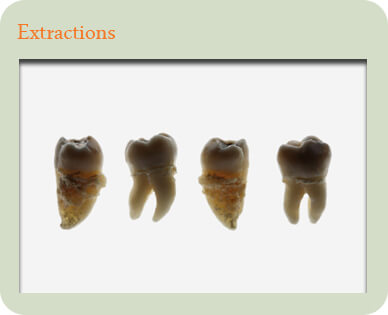
Common post extraction instructions / dry sockets Aftercare during the time period beginning 24 hours following your tooth extraction. Your dentist will provide you with a second set of aftercare instructions for the time period beginning 24 hours after your tooth extraction. Usually a dentist’s instructions will include directions pertaining to the topics found on this page. Before following any of the aftercare directions that are found here you should print them out and show them to your dentist and ask them if these instructions apply to your specific situation. Your dentist may find reason to revise, add to, or delete from these generalized instructions, depending on your specific needs. In all cases, if you have a concern or feel you have developed a complication associated with your tooth extraction you should contact your dentist.
Addressing swelling that still exists 24 hours after the extraction.
Any swelling caused by the trauma of the tooth extraction process should reach its maximum after 24 to 48 hours. So to bring this swelling down more quickly, apply a warm moist towel to the swollen area for 20 minutes followed by 20 minutes of no application. Repeat this cycle, as you find necessary.
Keeping the extraction site clean.
In general, the cleaner you keep the extraction site (the hole in the bone where the tooth has been removed, also referred to as the tooth’s socket) the quicker it will heal. Beginning 24 hours after your tooth extraction, you can gently rinse the socket with warm salt water (1/2 teaspoon of salt in a cup of water) after meals and before bed. Do not use commercial mouth rinses. They may irritate the extraction site.
Stitches (resorbable and non-resorbable).
Your dentist may have found it necessary to place sutures (“stitches”) in the extraction site after removing the tooth. Some types of stitches are resorbable (absorbable) and therefore will disintegrate and dissolve away on their own, others are not and will need to be removed by your dentist. If stitches were placed, make sure you know which type have been used. Usually a dentist will want to remove stitches that don’t resorb in about a week or so after the extraction. The process of removing stitches is usually very easy and quite painless.
Dry sockets.
One of the more common complications people experience after a tooth extraction is that of developing a “dry socket.” It is thought that dry sockets occur when either a blood clot has failed to form in the tooth socket (the hole left after extracting the tooth), or else the blood clot that did form has been dislodged. Since the formation of a blood clot is an important part of the healing process, the normal healing of the extraction site is interrupted.
Dry sockets are most frequently associated with difficult tooth extractions or extractions that have been traumatic in nature. An extraction that has involved the removal of bone from around a tooth in order for the dentist to access it, which is often the case when lower impacted wisdom teeth are removed, would be considered to be more traumatic in nature than an extraction where this step was not required.
People who follow their dentist’s post-extraction recommendations will reduce their chances of developing a dry socket. Dry sockets are found to occur more often with women (even more so with those taking oral contraceptives), people over the age of 30, and smokers.
Typically dry sockets manifest themselves as a dull throbbing pain which doesn’t appear until three or four days after the tooth extraction. The pain can be moderate to severe in intensity and often seems to radiate from the area of the extraction site to the ear. Dry sockets typically create a foul odor or bad taste. Visually, if you can see down into the socket, the extraction site appears “dry,” in the sense that you just see exposed bone. There is no formation of pus.
Bone sequestra and tooth fragments.
Sometimes small fragments of dead bone (called a “sequestrum” [singular] or “sequestra” [plural]) will come to the surface of an extraction site as they are ejected by the patient’s body during the healing process. This is more likely to occur in those cases where the tooth extraction has been relatively difficult or traumatic. Along these same lines, if the tooth broke or splintered during the extraction process you may find that small shards of tooth may come to the surface of the extraction site, even some weeks after the socket seems to have healed. You may be able to remove the smallest of these splinters of bone or tooth on your own, or you may find that you require, or want, your dentist’s assistance in removing them.
Completion of the healing process.
Of course after a tooth has been extracted there will be a hole left in your jawbone where the tooth has been removed (the tooth’s socket). As time passes the shape of this hole will smooth over and fill in with bone. While it can take many weeks and months for this healing process to occur fully, from a practical standpoint after 1 to 2 weeks enough healing will have occurred that the extraction site should be of only minor inconvenience to you.
 847.697.9900
847.697.9900




